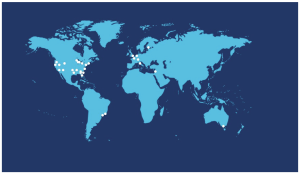A collaboration of 41 international clinical centres that manage patients affected with inherited retinal diseases (IRDs), supported by the US Foundation Fighting Blindness (FFB), have reported genetic data for almost 34,000 patients and families across the globe. The study provides the “largest assessment of genetic causality in the IRD patient population across multiple continents to date”. The objective of the poll to collect IRD data was to promote the understanding of IRDs and providing an “evidence-based support of which subset of diseases are appropriate targets for natural history studies and are useful for researchers determining which patient populations can best be served with the development of novel treatments”. FFB established the consortium of researchers in 2016, with the goal of accelerating the development of treatments for IRD patients. In their paper, an initiative by “My Retina Tracker (MRT) Open Access Genetic testing”, supported by FFB and industry, stated that there was an “offer no-cost genetic testing to patients with IRDs”.
The study collected data from 13 countries on four continents administering a survey annually to capture a snapshot of the number of patients with mutations in specific IRD genes. The consortium covered researchers in academe, private practice and government ophthalmology clinics polled to identify per-case IRD genetic causality from a list of 387 syndromic and non-syndromic IRD genes. The survey also assessed how genetic testing was obtained and clinical practices of the sites. Following the results, thirty (30) centres responded and reported genetic data from 33,834 patients (27,561 families).
Figure 1. Map of Consortium sites that participated in the 2022 gene poll. Licensed under a Creative Commons Attribution-NonCommercial-NoDerivatives 4.0 International License, entitled: Characterizing the Genetic Basis for Inherited Retinal Disease: Lessons Learned From the Foundation Fighting Blindness Clinical Consortium’s Gene Poll, by Branham et al. published in Invest Ophthalmol Vis Sci. 2025;66(2):12. https://doi.org/10.1167/iovs.66.2.12.
Disease-causing variants were reported in 293 of 387 genes. The most common genetic aetiologies were ABCA4 (17%), USH2A (9%), RPGR (6%), PRPH2 (5%), and RHO (4%). The top 100 genes accounted for the genetic cause of disease in 94.4% of patients and two-thirds of the centres had at least one genetic counsellor. In the 21 US sites, genetic testing was commonly obtained through sponsored programs (95%, FFB-My Retina Tracker Programs or “Spark-ID Your IRD”), whereas in the 9 non-US sites (6 sites in Europe, 2 sites in South America [both in Brazil], and 1 site in Israel), genetic testing was commonly obtained using either patient or public health system-funded testing pipelines. Clinical work-up of patients with IRD most commonly included updating history, eye examination, and optical coherence tomography.
A table of the top 5 gene overall and by region:
The two most common causes of disease across multiple studies and regions were ABCA4 and USH2A. In addition, the top five genes across all sites (ABCA4, USH2A, RPGR, PRPH2, and RHO) account for disease burden in 40.5% of patients, while “the
top 20 genes account for 67.7% of the disease burden, and the top one-half of the genes account for 99.2% of the disease burden”. Interestingly, the researchers also highlighted that not all patients may be able to access genetic testing for financial reasons. In the United States, 20 of 21 sites “used sponsored genetic testing programs to collect genetic data and all sites indicated that all or most of their genetic testing was supported by sponsored testing programs”. Contrastingly, in non-US sites, all or most of patients “obtained genetic testing through public or private health insurance or other methods, such as research agencies. Access to genetic testing will continue to be an important part of care for patients with IRDs”.


